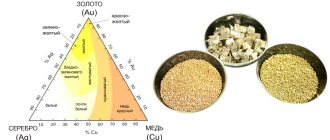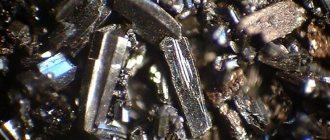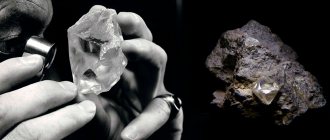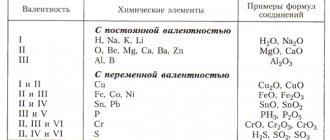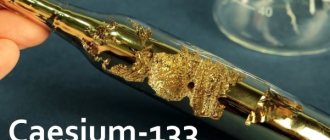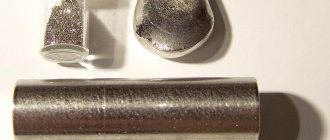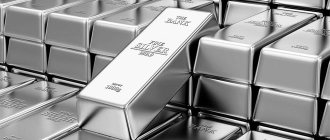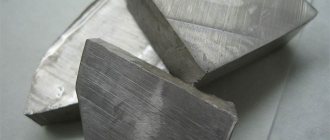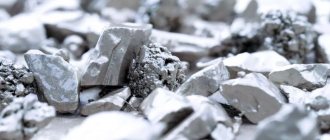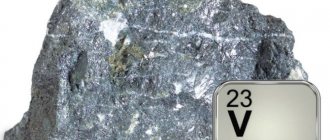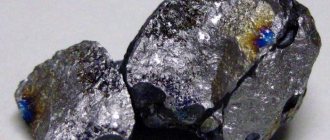– (Chromium) Cr, chemical element 6(VIb) of group of the Periodic table. Atomic number 24, atomic mass 51.996. There are 24 known isotopes of chromium from 42Cr to 66Cr. The isotopes 52Cr, 53Cr, 54Cr are stable. Isotopic composition of natural chromium: 50Cr (half-life 1.8 1017 years) – 4.345%, 52Cr – 83.489%, 53Cr – 9.501%, 54Cr – 2.365%. The main oxidation states are +3 and +6.
Also on topic:
CHEMISTRY
In 1761, chemistry professor at St. Petersburg University Johann Gottlob Lehmann, at the eastern foot of the Ural Mountains at the Berezovsky mine, discovered a wonderful red mineral, which, when crushed into powder, gave a bright yellow color. In 1766 Lehman brought samples of the mineral to St. Petersburg. Having treated the crystals with hydrochloric acid, he obtained a white precipitate, in which he discovered lead. Lehman called the mineral Siberian red lead (plomb rouge de Sibérie); it is now known that it was crocoite (from the Greek “krokos” - saffron) - a natural lead chromate PbCrO4.
The German traveler and naturalist Peter Simon Pallas (1741–1811) led an expedition of the St. Petersburg Academy of Sciences to the central regions of Russia and in 1770 visited the Southern and Middle Urals, including the Berezovsky mine and, like Lehmann, became interested in crocoite. Pallas wrote: “This amazing red lead mineral is not found in any other deposit. When ground into powder it turns yellow and can be used in artistic miniatures.” Despite the rarity and difficulty of delivering crocoite from the Berezovsky mine to Europe (it took almost two years), the use of the mineral as a coloring agent was appreciated. In London and Paris at the end of the 17th century. all noble persons rode in carriages painted with finely ground crocoite; in addition, the best examples of Siberian red lead replenished the collections of many mineralogical cabinets in Europe.
Also on topic:
CHROMATS AND DICHROMATS
In 1796, a sample of crocoite came to the professor of chemistry at the Paris Mineralogical School, Nicolas-Louis Vauquelin (1763–1829), who analyzed the mineral, but found nothing in it except oxides of lead, iron and aluminum. Continuing his research on Siberian red lead, Vaukelin boiled the mineral with a solution of potash and, after separating the white precipitate of lead carbonate, obtained a yellow solution of an unknown salt. When treated with lead salt, a yellow precipitate was formed, with mercury salt, a red one, and when tin chloride was added, the solution became green. By decomposing crocoite with mineral acids, he obtained a solution of “red lead acid,” the evaporation of which gave ruby-red crystals (it is now clear that it was chromic anhydride). Having calcined them with coal in a graphite crucible, after the reaction I discovered many fused gray needle-shaped crystals of a metal unknown to that time. Vaukelin noted the high refractoriness of the metal and its resistance to acids.
Vaukelin named the new element chromium (from the Greek crwma - color, color) due to the many multi-colored compounds it forms. Based on his research, Vauquelin was the first to state that the emerald color of some precious stones is explained by the admixture of chromium compounds in them. For example, natural emerald is a deep green colored beryl in which aluminum is partially replaced by chromium.
Most likely, Vauquelin obtained not pure metal, but its carbides, as evidenced by the needle-shaped shape of the resulting crystals, but the Paris Academy of Sciences nevertheless registered the discovery of a new element, and now Vauquelin is rightly considered the discoverer of element No. 24.
In 1798, Lowitz and Klaproth, independently of Vaukelin, discovered chromium in a sample of a heavy black mineral (it was chromite FeCr2O4), found in the Urals, but much north of the Berezovsky deposit. In 1799, F. Tassaert discovered a new element in the same mineral found in southeastern France. It is believed that it was Tassert who first managed to obtain relatively pure metal chromium.
What is
Chromium is a metal, element of the periodic table No. 24.
International designation and formula – Chromium, Cr.
The silvery-bluish shiny substance is one of the hardest (5.5 Mohs) and refractory metals, but is brittle. Refers to ferrous metals.
Its structure and properties are similar to iron, manganese, titanium, and nickel. These elements are combined into one family.
A unique feature of the element is the bright rainbow color of the compounds: blue, violet, green to emerald, yellow, orange, purple. They determined the name, thanks to them it is easy to distinguish chrome from other metals.
In ancient Greek χρῶμα (chroma) - paint, color.
Matte and glossy shades of chrome, how to combine with other colors
If we say what color chrome is, then it is close to gray, which can be combined with many shades. The paint is available in different shades.
The coating may have a matte or glossy finish. You can combine elements in the interior, but still there should be more matte surfaces. Too many reflective details can create a glow that is too cool.
It is advisable to use a contrasting combination of colors, heat and cold to create a cozy room.
They think about the introduction of each color in advance, especially metallic shades, so that there is no feeling that these objects ended up in the room by accident. An approximate ratio of 70 to 30 is made.
It is for chrome that it is suitable to combine only with natural paints - brown, brick, beige, white, brown, sand.
They think about the introduction of each color in advance, especially metallic shades.
Physico-chemical characteristics
The physical and chemical properties of chromium are typical of metals:
- Chemically inactive. Under normal conditions it does not interact with water or alkali solutions. The reaction starts at +600°C.
- Oxygen creates a protective oxide film on its surface.
- In compounds it exhibits three degrees: +2, +3, +6. The most stable are trivalent.
The use of chromium is hampered by disadvantages:
- Obvious deterioration of characteristics due to impurities in the composition.
- The need for additional processing of superhard metal to obtain plasticity.
However, they are compensated by the advantages of the metal: refractoriness, hardness (the fifth among metals), and resistance to corrosion.
| Properties of the atom | |
| Name, symbol, number | Chrome / Chromium (Cr), 24 |
| Atomic mass (molar mass) | 51.9961(6) a. e.m. (g/mol) |
| Electronic configuration | [Ar] 3d5 4s1 |
| Atomic radius | 130 pm |
| Chemical properties | |
| Covalent radius | 118 pm |
| Ion radius | (+6e)52 (+3e)63 pm |
| Electronegativity | 1.66 (Pauling scale) |
| Electrode potential | −0,74 |
| Oxidation states | 6, 3, 2, 0 |
| Ionization energy (first electron) | 652.4 (6.76) kJ/mol (eV) |
| Thermodynamic properties of a simple substance | |
| Density (at normal conditions) | 7.19 g/cm³ |
| Melting temperature | 2130 K (1856.9 °C) |
| Boiling temperature | 2945 K (2671.9 °C) |
| Ud. heat of fusion | 21 kJ/mol |
| Ud. heat of vaporization | 342 kJ/mol |
| Molar heat capacity | 23.3 J/(K mol) |
| Molar volume | 7.23 cm³/mol |
| Crystal lattice of a simple substance | |
| Lattice structure | cubic body-centered |
| Lattice parameters | 2.885 Å |
| Debye temperature | 460 K |
| Other characteristics | |
| Thermal conductivity | (300 K) 93.9 W/(mK) |
| CAS number | 7440-47-3 |
Is chrome plating necessary?
Applying chrome to individual parts and body elements has become a common procedure. Similar services are offered in almost every workshop, and there are also instructions for performing work at home. The only question remains: is there any point in wasting time and money?
- A thin layer of heavy metal provides additional protection on several points at once. From the point of view of the functional application of the proven process, no disadvantage can be found.
- The surface acquires a pleasant shine and requires minimal maintenance, which makes it an excellent solution for lazy motorists.
- After chrome plating, the service life increases. This fact is confirmed by practical analytical data that show how profitable it is to turn to specialists.
- The costs of carrying out the work are incomparably lower than the benefits obtained. You don’t have to worry about expenses, as they remain small.
There is no need to talk about the advantages and disadvantages; it is much easier to highlight only a few points that best describe chrome plating. They are enough to make a decision that makes you think about additional costs. Still, taking care of your car guarantees its longevity and reduces regular maintenance and care costs.
Chromium is a heavy metal that has not been used in industry for years. Its heavy weight and high cost forced it to abandon its beneficial properties. Today, the process of creating the thinnest layer on any metal surface has been studied in detail. It acquires the same advantages, so it remains reliable for a long time during operation. So it’s time for drivers to forget about saving money and seriously think about changes to their own vehicle, which will affect not only the appearance.
Being in nature
Two dozen chromium minerals have been identified in nature. The main ones are chromite and crocoite.
Igneous rocks contain different concentrations of the element (g/t):
- ultrabasic – 2000;
- basalts, other basic ones – 200.
Each ton of the earth's crust contains on average 83 g of chromium.
One class of industrial interest is chrome spinels.
The metal contains precious stones - chrome tourmaline, uvarovite (chrome garnet), and others.
Receiving technology
The traditional raw material for chromium production is chrome spinels.
The main methods of obtaining metal are ore enrichment by electrolysis or reduction.
To increase the purity of the final product, the raw materials are fused in an electric furnace with soda, adding oxygen.
The production of metallic chromium of almost absolute purity is carried out by the electrolysis of concentrated chromium solutions or by the reduction of chromium oxide with aluminum in vacuum furnaces (at 1500°C).
Use in interior decoration
Due to the coldness, the chrome tint is rarely present on finishing materials. But for some styles, the option can give a unique design.
Due to the coldness, the chrome tint is rarely present on finishing materials.
Ceiling, floor and walls
Dark gray floors should transition into a warm tone or a lighter version of gray. On the ceiling, chrome can be used only for small details. Wallpaper with patterns in gray tones with a mirror effect is glued to the walls. But it’s still better to limit yourself to one wall.
Dark gray floors should transition into a warm tone or a lighter version of gray.
Where is it used?
The metal is used in two ways: as a ligature for other metals and as a coating.
Metallurgy
An industry that takes up three quarters of metal volumes. Steel is alloyed with chromium to improve its quality.
Receive the product:
- stainless;
- wear-resistant;
- heat resistant.
Such advantages of steels led to their use as a material for artillery barrels, submarine hulls, safes, metal-cutting, medical, and chemical instruments. The engines of spaceships and the filling of plasmatrons are made from them.
Even a small amount of chromium in the composition significantly improves the mechanical properties of the material.
The most famous chromium-containing alloys are with nickel (nichrome) and iron (fechral). These are precision materials with increased electrical resistance. Used to work at extreme temperatures.
Other industries
Products made from metal and its alloys are produced for different market segments:
- Bricks are the body of metallurgical furnaces.
- Heating elements (nickel alloy).
- Surgical instruments (alloy with nickel, molybdenum, cobalt).
- Chromium compounds are useful in the production of matches, shoes, clothing (the famous shiny-durable chrome leather), dyeing textiles, and processing furniture wood.
- Green chrome paint is applied to the ceramic before glazing and firing.
Paints made from ground chrome ores were also used by icon painters of Ancient Rus'.
- Trivalent metal oxide is the starting material for growing synthetic rubies for lasers.
- The green fireworks lights are thanks to chrome.
Chrome is purchased by pharmaceutical giants, manufacturers of dietary supplements, and weight loss drugs.
Decor
Chrome plating on a watch case or car parts is not only a status marker. This treatment protects against wear, corrosion, and mechanical damage.
The thickness of the metal coating depends on the purpose of the product: from 2 microns (decorative assortment) to 0.1 mm (parts of bikes, bicycles, cars).
The process of coating with chromium is called chrome plating. It is technologically simple and inexpensive.
Application of chromium
The use of chromium is not very widespread. 85% of the chromium produced is used for the production of metal alloys. The remaining 15% of chromium is used in chemical, refractory and foundry industries.
Ferrochrome is a classic intermediate material for the production of special steels such as stainless steels and nickel-based steels. In metallurgy, chromium is used to make hard and resistant alloys. Chrome plating of metals or chrome galvanizing improves corrosion resistance and also gives an aesthetic appearance to the product.
Some chromium-based oxides and salts are used to color glass. An example is trivalent chromium for coloring bottles green. Chromates and oxides are also used as coloring pigments in paints and dyes. Dyes and paints are used to color yellow-green to yellow-orange colors. Alum, chromium-based etchants and tannins are used to treat animal hides and skins.
Chromium and some of its compounds are catalysts. Thus, in certain hydrogenation reactions, but also in tricarbonylated form as the activating group of benzene, they allow numerous chemical transformations. Potassium dichromate is a powerful oxidizing agent that is used in laboratory chemistry to remove traces of organic matter from processed materials. An example would be glassware.
Read: Calcium as a chemical element on the periodic table
Meaning for humans
Chromium is present in the human body initially.
Health
He is a participant in a number of biological processes:
- Lipid, carbon metabolism.
- Removing “bad” cholesterol
- Blood sugar balance.
- Strengthening bone tissue.
- Activation of insulin action.
- Ability to replace iodine.
- Stimulation of tissue regeneration.
A sufficient level of chromium in the body is critical for people with excess weight, diabetes, diseases of the thyroid gland, heart, and blood vessels.
Nutrition
Products from all main groups are rich in chromium:
- Meat – chicken, beef (and liver);
- Fish – mackerel, tuna, herring.
- Cereals – semolina, pearl barley.
- Vegetables – tomatoes, radishes, green onions.
Cheeses, legumes, corn oil, fruits, coarse bread, and brewer's yeast are saturated with metal.
Dosage
Daily requirement for chromium (mcg):
- Children – 12-34 (depending on age).
- Women – 55-68.
- Men – 59-79.
During pregnancy in women, an active lifestyle, and physical activity in men, the need doubles.
Types of chrome ores
According to industrial types of deposits, several types of chromium ores are distinguished. Among them are:
- endogenous;
- exogenous;
- technogenic.
Endogenous
According to the conditions of formation, endogenous ores are divided into two types:
- Early magmatic. The deposits were formed at the early stage of the formation of intrusions (igneous rocks) and occur in the lower massifs. Medium chromium ores, solid, refractory (South Africa, Finland, USA, India).
- Late magmatic. The ores were formed during the late period of intrusive formation. The main source of high-chromium metallurgical and refractory ores (Greece, Turkey, Yugoslavia, Albania).
Exogenous (placer)
The deposits arise as a result of weathering destruction of endogenous chromite ore deposits. Industrial importance is quite limited (Japan, Yugoslavia, Philippines, Cuba).
Technogenic
Ores are mined on the surface of the Earth or from special dumps of off-balance ores formed during the development of chromium deposits during the process of ore enrichment. The raw materials are suitable for industrial use. The economic benefit lies in the fact that the development is carried out on the surface.
